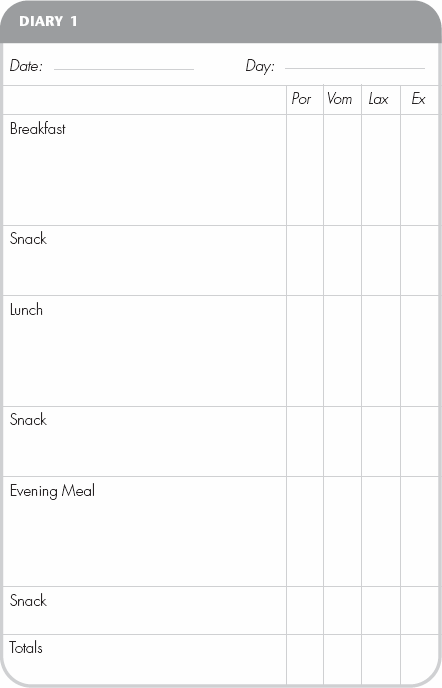
The first concrete step is to record daily everything that you eat and drink. You may find it helpful to use the diary sheets provided here (and at the end of the book). If you have access to a photocopier, copy the blank sheets printed here and keep them together when you have filled them in. If you do not, buy a notebook and make a diary yourself, following a similar layout. It will help if your notebook is of a small, convenient size so that you can carry it with you at all times.
You will see that the diary sheets have four columns to the right of the spaces where you will record what you eat and drink. The first column, headed ‘Por’, is where you will record the number of portions you have eaten when you use the portion system outlined in Step 5; don’t worry about this for now. You can and should, however, record from the beginning in the appropriate columns when and how many times you vomit (‘Vom’), take laxatives (‘Lax’) and/or exercise (‘Ex’) after eating. You should also record in the wide left-hand column any binges you may have and what you consumed in them; these foods and drinks should be placed in brackets.
Try to keep your food diary up to date through the day rather than waiting until the evening to remember what you have eaten throughout the day. If you write down everything as soon as possible after eating and drinking, it will be easier to make sure the record is accurate.
People take differently to diary writing. Some find it helps them feel in control and easily maintain a full, accurate diary, while others find it hard and time-consuming. If you find it difficult, try to focus your efforts on particular days: two fully recorded days out of a week will be more valuable than a whole week of semi-completed days.
You may well find at first that your diary shows a very self-restrained diet, with lots of black coffee and diet drinks and very definite patterns of ‘allowed’ foods. You may also notice how you use exercise after eating to ‘work off’ the meal. The next step is to try to make yourself more aware of, and to move toward, the principles of normal eating.
The principles of normal eating, shown below, are a set of targets toward which you should aim – not a set of rules which must all be kept rigidly all at once. Your plan is to take steps toward normal controlled eating, testing out each new practice at a pace that is tolerable to you, even if this means that progress appears to be very slow. Remember, you are more likely to lose heart and give up if you try to be too ambitious too soon than if you persevere little by little and give yourself time to get used to different ways of eating.
Once you have managed to follow these guidelines for some time, you will then be in a much stronger position to make more substantial changes to your diet and eating patterns.
It cannot be stressed too much that these principles are recommendations to aim for; you are highly unlikely to achieve them quickly or without taking risks and experimenting. The important thing is that you become aware of a different, healthier way of fitting food into your life.
There are various ways in which you can help yourself as you set out on your journey towards change. The task ahead of you is a hard one, so do take every opportunity to make it a little easier.